Passive Vector Sensing for Non-Cooperative Emitter Localization in Indoor Environments
Abstract
1. Introduction
2. Vector Sensing with a Triad Dipole Vector Sensor
3. Simulated Room Localization of Non-Cooperative Emitters
3.1. Indoor Environment
3.2. Room Localization
3.2.1. Fingerprint Generation
3.2.2. Feature Extraction
3.2.3. Classification
3.3. Room Localization Discussion
| Algorithm 1 Training Percentage and Cross-Validation without Monte Carlo Trials | |
| 1: for to 2 do | |
| 2: | |
| 3: for to | |
| 4: | |
| 5: if then | ▹ Perform C-fold cross-validation |
| 6: | |
| 7: | ▹ Training % |
| 8: | |
| 9: | |
| 10: | |
| 11: | |
| 12: | |
| 13: else | ▹ Perform C-fold cross-validation |
| 14: | |
| 15: | |
| 16: | |
| 17: | ▹ Training % |
| 18: | |
| 19: | |
| 20: | |
| 21: end if | |
| 22: | |
| 23: end for | |
| 24: | |
| 25: end for | |
3.4. Room Localization Results
4. Experimental Room Localization of Non-Cooperative Emitters
4.1. Room Localization Discussion
4.2. Room Localization Results
Improving RSS Room Localization Performance via TDVS
4.3. Noise Considerations on Room Localization Performance
5. Simulated Region of Interest Localization
5.1. Feature Vectors
5.1.1. Channel Equalization
5.1.2. CSI Estimation
5.2. Probabilistic Cluster Modeling for RoI Localization
- Initialize the component mixture probability with equally-likely probability (i.e., ) and define the covariance to be diagonal and identical, i.e.,as is the variance of the data in the cluster, , and K is the number of clustering components selected. The cluster mean is then selected by minimizing the cost as a function of the squared Euclidean distance via K-means between the data sample and cluster mean described aswhere denotes the data sample and is defined aswhere in (34) defines the mean within the set of K cluster means such that if the data sample is assigned to cluster k, and for . The selection of and is performed through the minimization of in (33) until convergence is obtained.
- Initialize the GMM with defined parameters and in (32) that are initialized in the K-means process and iteratively perform the expectation step (E-step) followed by the maximization step (M-step) according to [32] until convergence is achieved and all responsibilities (31) are assigned.
6. Conclusions
Author Contributions
Funding
Conflicts of Interest
Abbreviations
| CSI | Channel State Information |
| DoA | Direction of Arrival |
| GMM | Gaussian Mixture Model |
| GSM | Global System for Mobile Communication |
| LDA | Linear Discriminant Analysis |
| LoS | Line-of-Sight |
| MCMA | Modified Constant Modulus Algorithm |
| NLoS | Non-Line-of-Sight |
| NRZ | Non-Return-to-Zero |
| PCA | Principal Component Analysis |
| RoI | Region of Interest |
| RRCF | Root-Raised-Cosine Filter |
| RSS | Received Signal Strength |
| STFT | Short-Time Fourier Transform |
| TDVS | Triad Dipole Vector Sensor |
| ToA | Time of Arrival |
| UMTS | Universal for Mobile Telecommunications System |
| WCDMA | Wideband Code Division Multiple Access |
| WKNN | Weighted K-Nearest-Neighbor |
| WT | Wavelet Transform |
References
- Aly, H.; Youssef, M. An analysis of device-free and device-based WiFi-localization systems. Int. J. Ambient. Comput. Intell. 2014, 6, 1–19. [Google Scholar] [CrossRef]
- Roos, T.; Myllymäki, P.; Tirri, H.; Misikangas, P.; Sievänen, J. A probabilistic approach to WLAN user location estimation. Int. J. Wirel. Inf. Netw. 2002, 9, 155–164. [Google Scholar] [CrossRef]
- Guo, L.; Wang, L.; Liu, J.; Zhou, W. A survey on motion detection using WiFi signals. In Proceedings of the 12th IEEE International Conference on Mobile Ad-Hoc and Sensor Networks (MSN), Hefei, China, 16–18 December 2016; pp. 202–206. [Google Scholar] [CrossRef]
- Xiao, F.; Guo, Z.; Zhu, H.; Xie, X.; Wang, R. AmpN: Real-time LOS/NLOS identification with WiFi. In Proceedings of the IEEE International Conference on Communications (ICC), Paris, France, 21–25 May 2017. [Google Scholar] [CrossRef]
- Wu, C.; Yang, Z.; Xiao, C. Automatic radio map adaptation for indoor localization using smartphones. IEEE Trans. Mob. Comput. 2018, 17, 517–528. [Google Scholar] [CrossRef]
- Zou, H.; Zhou, Y.; Jiang, H.; Huang, B.; Xie, L.; Spanos, C. Adaptive localization in dynamic indoor environments by transfer kernel learning. In Proceedings of the 2017 IEEE Wireless Communications and Networking Conference (WCNC), San Francisco, CA, USA, 19–22 March 2017. [Google Scholar] [CrossRef]
- Ghosh, D.; Roy, P.; Chowdhury, C.; Bandyopadhyay, S. An ensemble of condition based classifiers for indoor localization. In Proceedings of the IEEE International Conference on Advanced Networks and Telecommunications Systems (ANTS), Bangalore, India, 6–9 November 2016. [Google Scholar] [CrossRef]
- Bulten, W.; Rossum, A.C.V.; Haselager, W.F.G. Human SLAM, indoor localisation of devices and users. In Proceedings of the 1st IEEE International Conference on Internet-of-Things Design and Implementation (IoTDI), Berlin, Germany, 4–8 April 2016; pp. 211–222. [Google Scholar] [CrossRef]
- Youssef, M.; Agrawala, A.K. The Horus location determination system. Wirel. Netw. 2008, 14, 357–374. [Google Scholar] [CrossRef]
- Wang, X.; Gao, L.; Mao, S. CSI phase fingerprinting for indoor localization with a deep learning approach. IEEE Internet Things J. 2016, 3, 1113–1123. [Google Scholar] [CrossRef]
- Zhu, D.; Pang, N.; Li, G.; Liu, S. WiseFi: Activity localization and recognition on commodity off-the-shelf WiFi devices. In Proceedings of the 2016 IEEE 18th International Conference on High Performance Computing and Communications; IEEE 14th International Conference on Smart City; IEEE 2nd International Conference on Data Science and Systems (HPCC/SmartCity/DSS), Sydney, NSW, Australia, 12–14 December 2016; pp. 562–569. [Google Scholar] [CrossRef]
- Wu, K.; Xiao, J.; Yi, Y.; Chen, D.; Luo, X.; Ni, L.M. CSI-based indoor localization. IEEE Trans. Parallel Distrib. Syst. 2013, 24, 1300–1309. [Google Scholar] [CrossRef]
- Mušicki, D.; Koch, W. Geolocation using TDOA and FDOA measurements. In Proceedings of the 11th IEEE International Conference on Information Fusion, Cologne, Germany, 30 June–3 July 2008. [Google Scholar]
- Tseng, P.-H.; Lee, K.-T. A femto-aided location tracking algorithm in LTE-A heterogeneous networks. IEEE Trans. Veh. Technol. 2017, 66, 748–762. [Google Scholar] [CrossRef]
- Lin, D.-B.; Juang, R.-T. Mobile location estimation based on differences of signal attenuations for GSM systems. IEEE Trans. Veh. Technol. 2005, 54, 1447–1454. [Google Scholar] [CrossRef]
- Van Doorn, E.; Bhat, A.; Lonske, B.; Guo, Z.; Hovareshti, P.; Gaddam, S. Time Difference of Arrival System for Cell Phone Localization in Correctional Facilities; Final Report on National Institute of Justice, Contract No. # 2011-IJ-CX-K002; U.S. Department of Justice: Washington, DC, USA, 2015; 72p.
- Tzoreff, E.; Bobrovsky, B.Z.; Weiss, A. Single receiver emitter geolocation based on signal periodicity with oscillator instability. IEEE Trans. Signal Process. 2014, 62, 1377–1385. [Google Scholar] [CrossRef]
- O’Connor, A.; Setlur, P.; Devroye, N. Single-sensor RF emitter localization based on multipath exploitation. IEEE Trans. Aerosp. Electron. Syst. 2015, 51, 1635–1651. [Google Scholar] [CrossRef]
- Narayanan, R.M.; Phelan, B.R.; Lenzing, E.H. Source geolocation in urban environments using multipath fingerprinting. Int. J. Antennas Propag. 2015, 2015, 453157. [Google Scholar] [CrossRef]
- Zou, Y.; Wan, Q. Emitter source localization using time-of-arrival measurements from single moving receiver. In Proceedings of the 2017 IEEE International Conference on Acoustics, Speech and Signal Processing (ICASSP), New Orleans, LA, USA, 5–9 March 2017; pp. 3444–3448. [Google Scholar] [CrossRef]
- Daldorff, L.K.S.; Turaga, D.S.; Verscheure, O.; Biem, A. Direction of Arrival estimation using single tripole radio antenna. In Proceedings of the IEEE International Conference on Acoustics, Speech and Signal Processing (ICASSP), Taipei, Taiwan, 19–24 April 2009; pp. 2149–2152. [Google Scholar] [CrossRef]
- Chen, L.; Aminaei, A.; Falcke, H.; Gurvits, L. Optimized estimation of the Direction of arrival with single tripole antenna. In Proceedings of the 2010 Loughborough Antennas & Propagation Conference, Loughborough, UK, 8–9 November 2010; pp. 93–96. [Google Scholar] [CrossRef]
- Compton, R.T. The tripole antenna: An adaptive array with full polarization flexibility. IEEE Trans. Antennas Propag. 1981, 29, 944–952. [Google Scholar] [CrossRef]
- Lundback, J.; Nordebo, S. Analysis of a tripole array for polarization and direction of arrival estimation. In Proceedings of the 2004 IEEE Sensor Array and Multichannel Signal Processing Workshop Proceedings, Barcelona, Spain, 18–21 July 2004; pp. 284–288. [Google Scholar] [CrossRef]
- Zhang, T.; Jia, Y.; Jiang, W.; Gao, J.; Yan, S.; Meng, H. Wireless indoor localization based on multispectral waterfall maps. In Proceedings of the 2014 XXXIth URSI General Assembly and Scientific Symposium (URSI GASS), Beijing, China, 16–23 August 2014. [Google Scholar] [CrossRef]
- Tarzia, S.P.; Dinda, P.A.; Dick, R.P.; Memik, G. Indoor localization without infrastructure using the acoustic background spectrum. In Proceedings of the 9th ACM International Conference on Mobile Systems, Applications, and Services (MobiSys’11), New York, NY, USA, 28 June–1 July 2011; pp. 155–168. [Google Scholar] [CrossRef]
- Leong, S.; Zheng, Y.R.; Xiao, C. Space-time fading correlation functions of a 3-D MIMO channel model. In Proceedings of the 2004 IEEE Wireless Communications and Networking Conference, Atlanta, GA, USA, 21–25 March 2004; pp. 1127–1132. [Google Scholar] [CrossRef]
- Durgin, G.D. Space-Time Wireless Channels, 1st ed.; Prentice Hall Press: Upper Saddle River, NJ, USA, 2002; ISBN 978-0130656476. [Google Scholar]
- Thompson, R.; Cetin, E.; Dempster, G. Unknown source localization using RSS in open areas in the presence of ground reflections. Proceedings of 2012 IEEE/ION Position, Location, and Navigation Symposium, Myrtle Beach, SC, USA, 23–26 April 2012; pp. 1018–1027. [Google Scholar] [CrossRef]
- Mallat, S. A Wavelet Tour of Signal Processing: The Sparse Way, 3rd ed.; Academic Press, Inc.: Burlington, MA, USA, 2008; ISBN 978-0123743701. [Google Scholar]
- Najmi, A.; Sadowsky, J. The continuous wavelet transform and variable resolution time-frequency analysis. Johns Hopkins APL Tech. Dig. 1997, 18, 134–140. [Google Scholar]
- Bishop, C.M. Pattern Recognition and Machine Learning; Springer: Berlin, Germany, 2016; ISBN 978-0387310732. [Google Scholar]
- Turk, M.; Pentland, A. Eigenfaces for recognition. J. Cognit. Neurosci. 1991, 3, 71–86. [Google Scholar] [CrossRef] [PubMed]
- Duda, R.O.; Hart, P.E.; Stork, D.G. Pattern Classification, 2nd ed.; Wiley-Interscience: New York, NY, USA, 2001; ISBN 978-0471056690. [Google Scholar]
- Oh, K.N.; Chin, Y.O. Modified constant modulus algorithm: blind equalization and carrier phase recovery algorithm. In Proceedings of the 1995 IEEE International Conference on Communications, Seattle, WA, USA, 18–22 June 1995; pp. 498–502. [Google Scholar] [CrossRef]
- Xiao, C.; Wu, J.; Leong, S.; Zheng, Y.R.; Letaief, K.B. A discrete-time model for triply selective MIMO Rayleigh fading channels. IEEE Trans. Wirel. Commun. 2004, 3, 1678–1688. [Google Scholar] [CrossRef]
- Van der Maaten, L.; Hinton, G. Visualizing data using t-SNE. J. Mach. Learn. Res. 2008, 9, 2579–2605. [Google Scholar]
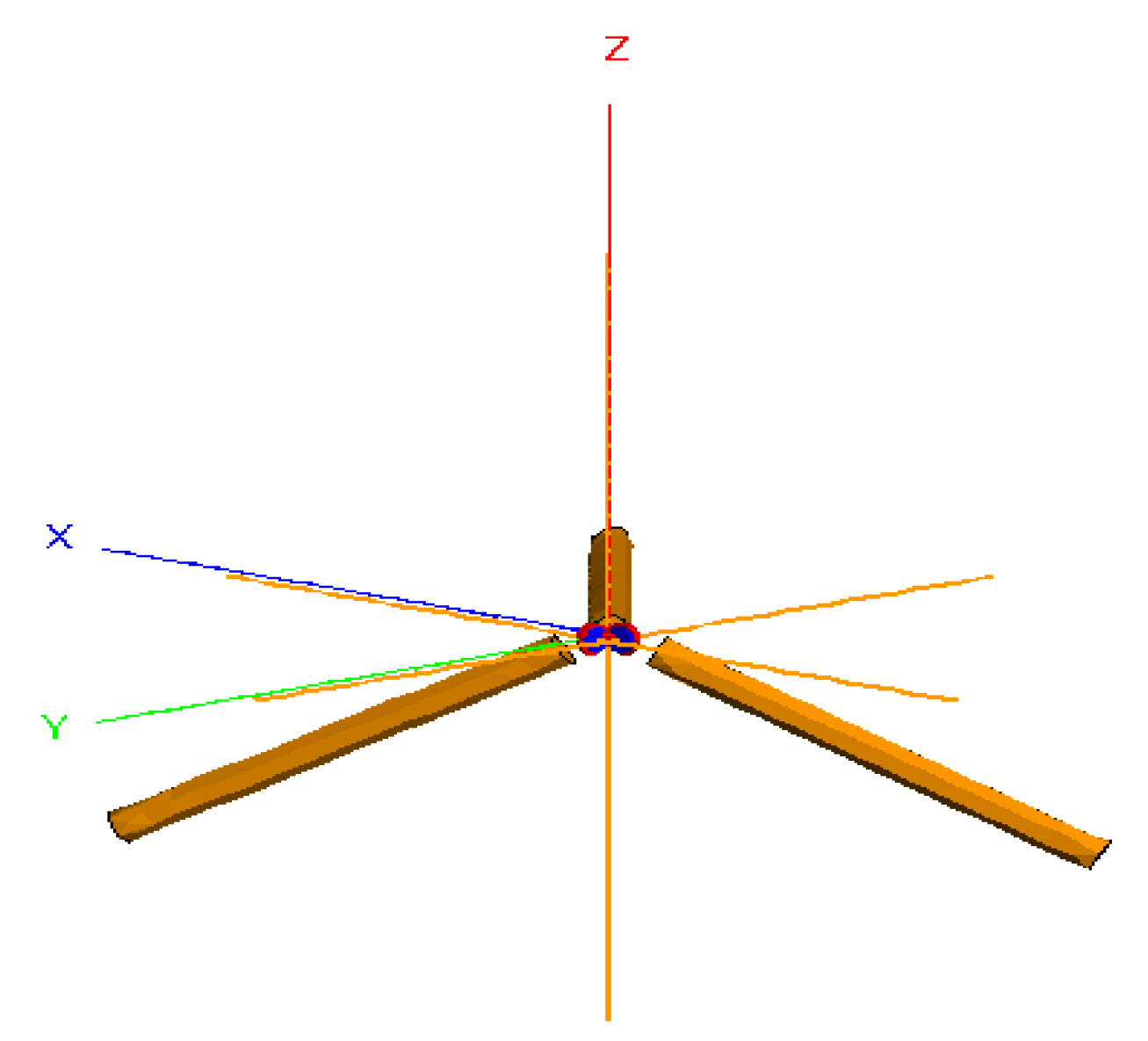
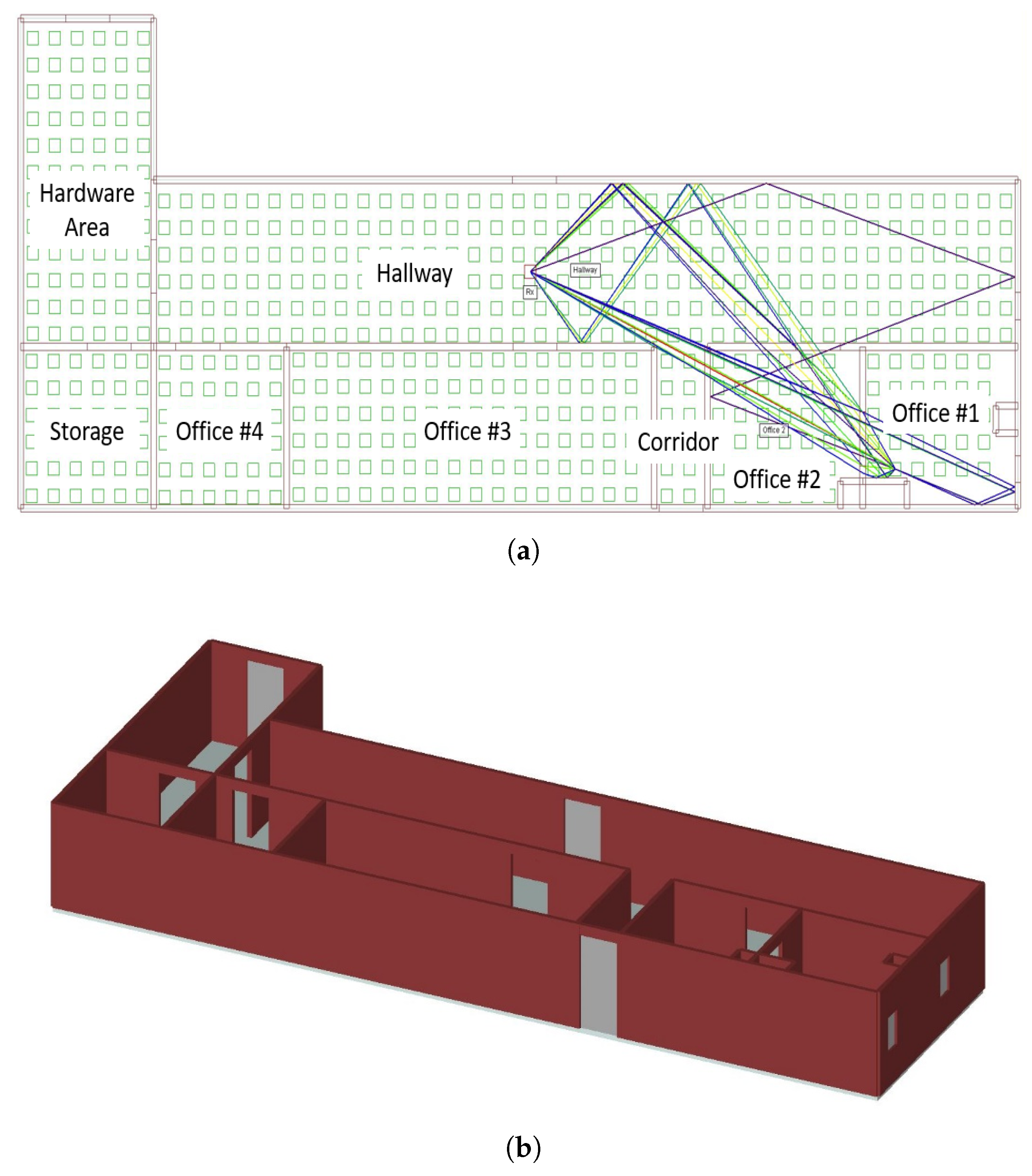
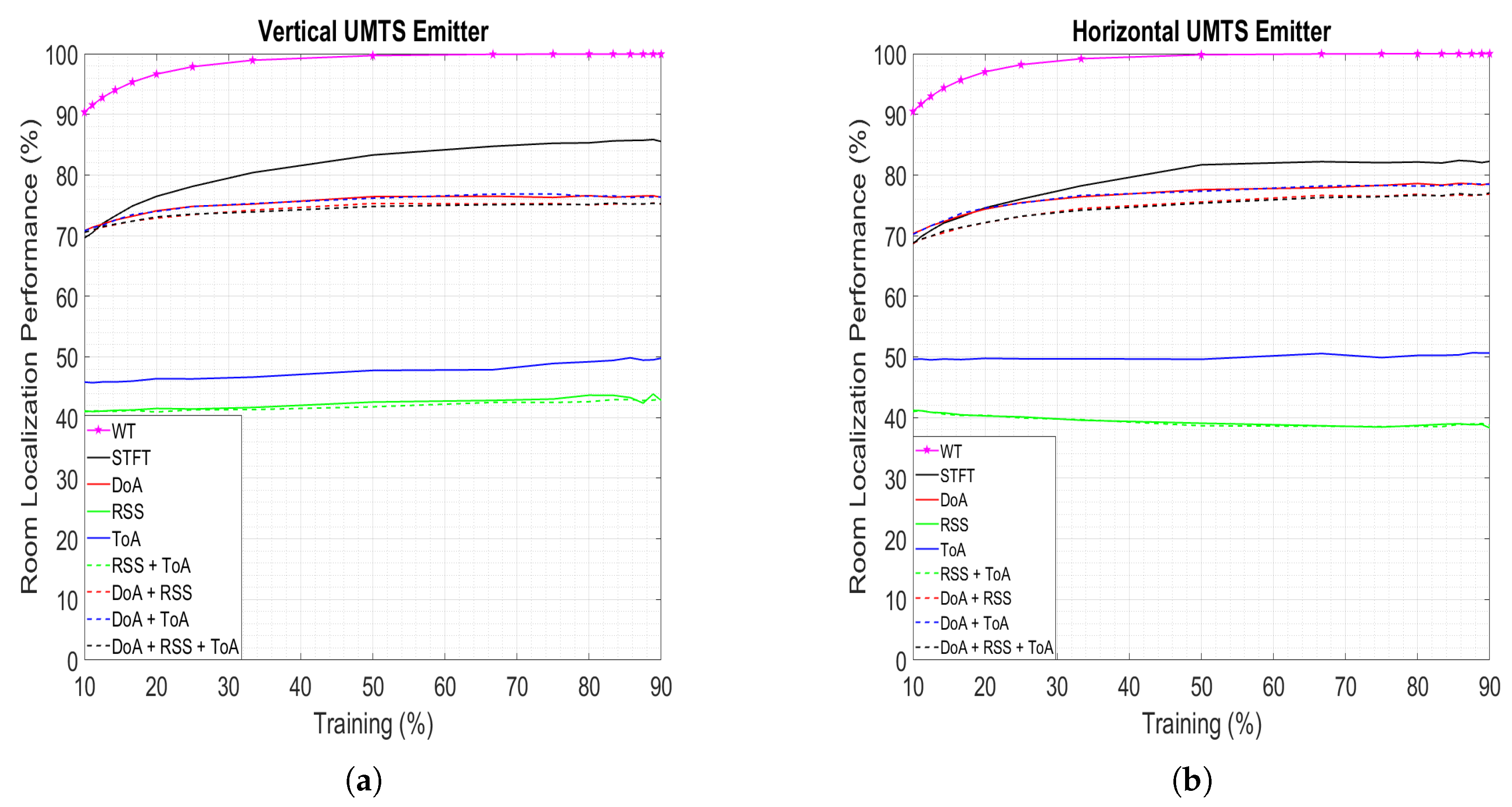
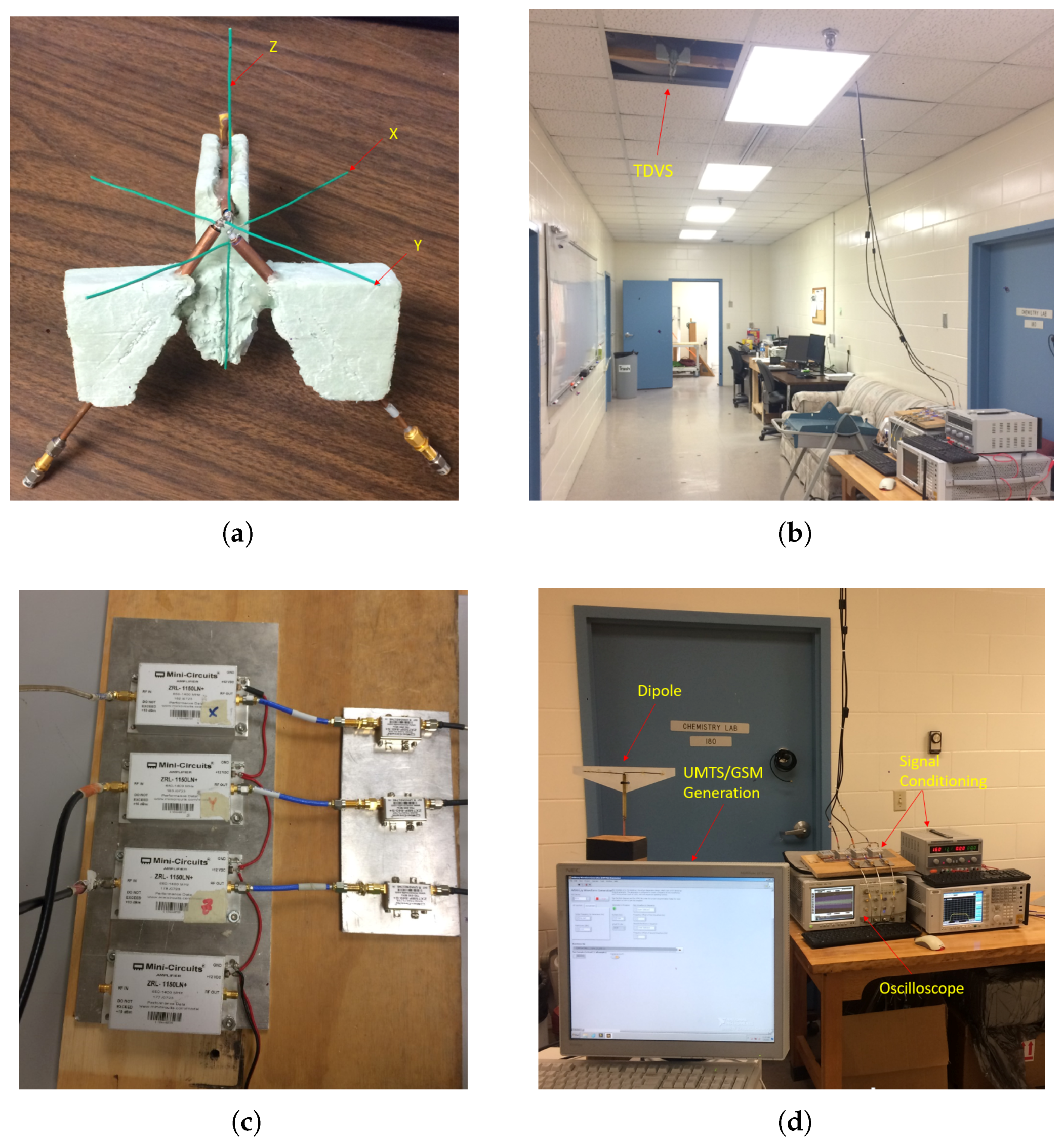

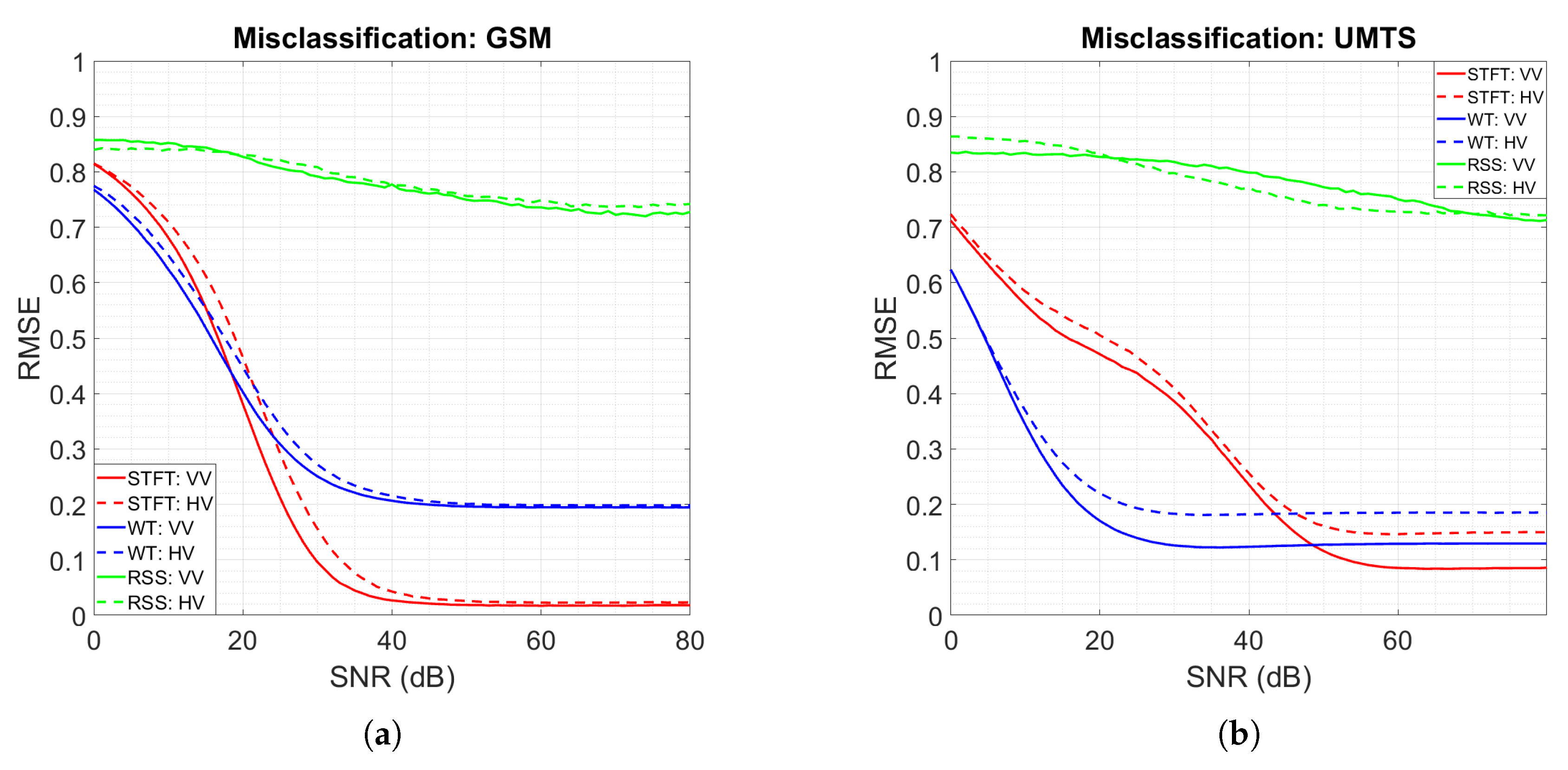
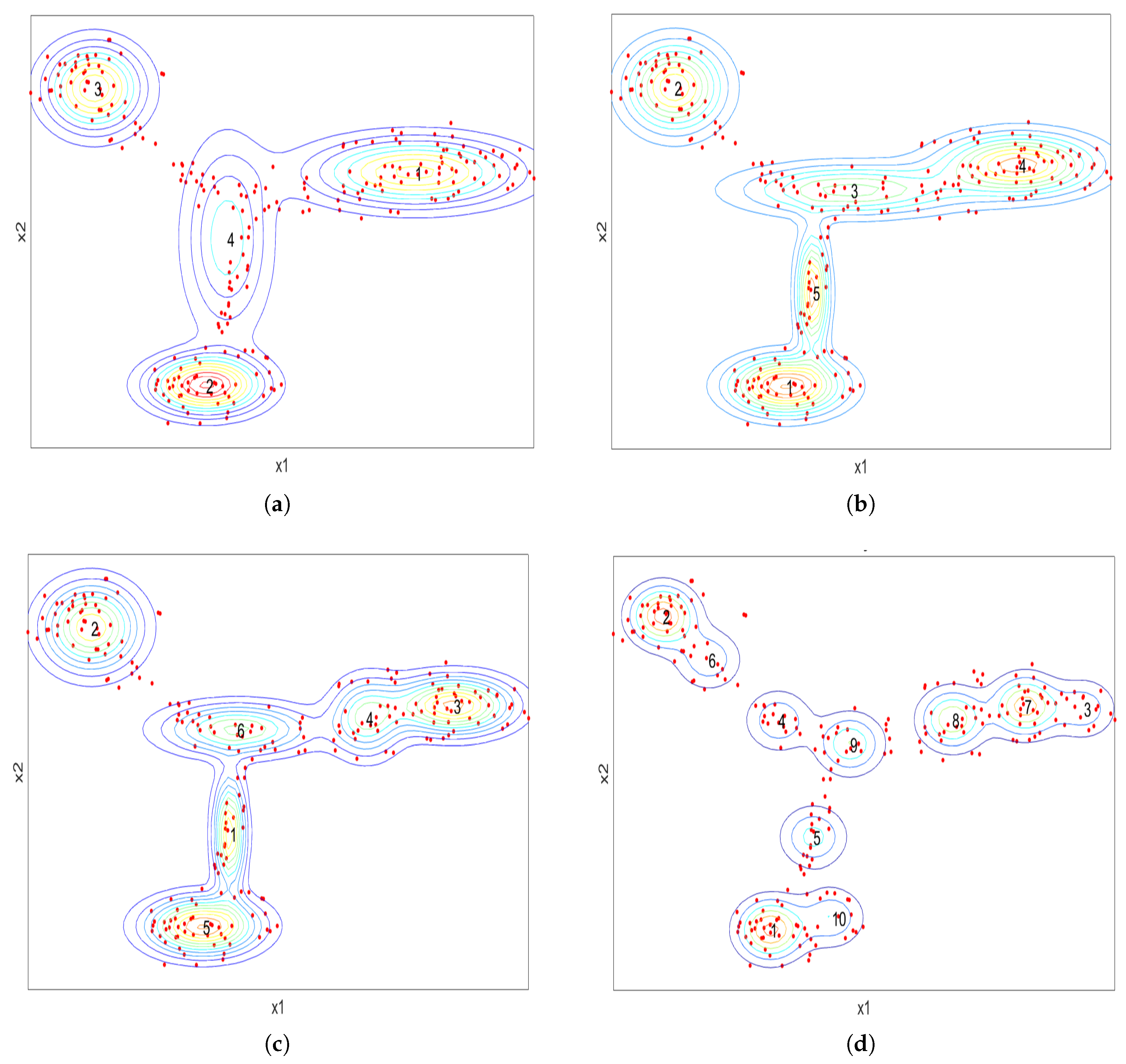
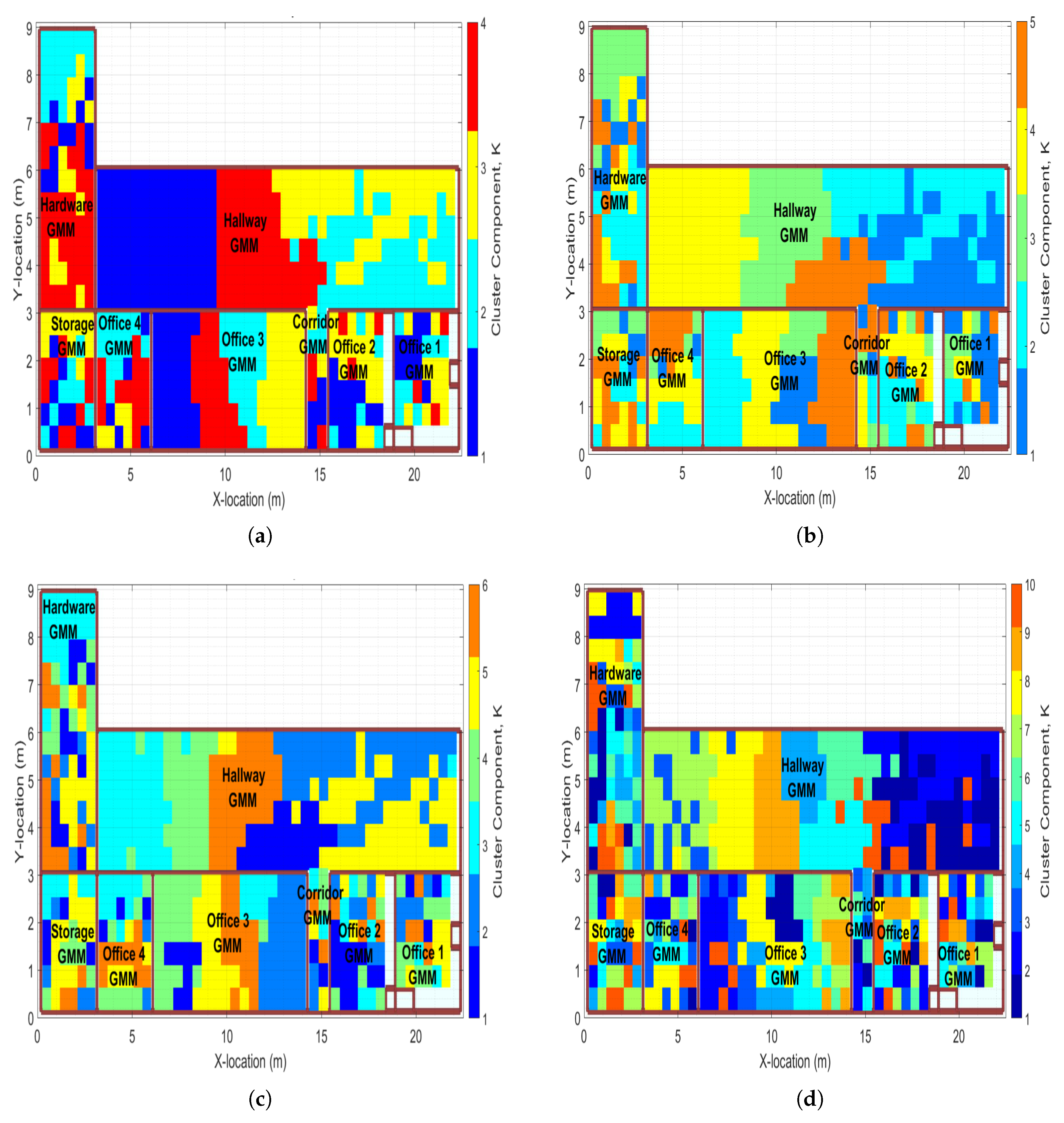
| Parameters | Conventional | Proposed |
|---|---|---|
| Reflections | 5 | 5 |
| Diffractions | 1 | 1 |
| Propagation Paths | 25 | 25 |
| Signal Type | UMTS | UMTS |
| Carrier Frequency | 831.86 MHz | 831.86 MHz |
| Bandwidth (BW) | 4.68 MHz | 4.68 MHz |
| Sampling Frequency | ||
| Filter Roll-Off | 0.22 | 0.22 |
| Transmitter Polarization | Vertical & Horizontal | Vertical & Horizontal |
| Receiver Polarization | Vertical | Vertical |
| Antenna | Dipole | 3-Element Vector Sensor |
| Output Features | RSS, ToA, DoA | 3D Received Signal, |
| WKNN Neighbors | 5 | 5 |
| STFT Window | - | Hamming |
| WT Wavelet | - | Morlet |
| Principal Components | - | 5 (85% Total Variance) |
| Linear Discriminants | - | 7 () |
| Room Localization Performance | ||||||||||
|---|---|---|---|---|---|---|---|---|---|---|
| Net.: Pol. | Approach | Hardware | Storage | Hallway | Office #4 | Office #3 | Corridor | Office #2 | Office #1 | Overall |
| GSM: V | STFT | 98.77% | 98.75% | 99.21% | 99.27% | 98.80% | 98.25% | 99.85% | 99.83% | 99.01% |
| − | WT | 74.04% | 79.80% | 92.51% | 77.65% | 85.47% | 76.01% | 83.67% | 82.81% | 81.49% |
| − | RSS | 28.85% | 56.05% | 47.93% | 16.91% | 23.08% | 21.65% | 13.95% | 23.63% | 25.25% |
| GSM: H | STFT | 98.98% | 97.45% | 98.43% | 97.29% | 99.30% | 99.69% | 98.64% | 98.90% | 98.58% |
| − | WT | 70.47% | 71.31% | 91.81% | 79.87% | 90.44% | 85.62% | 81.16% | 79.43% | 81.26% |
| − | RSS | 17.24% | 14.50% | 39.35% | 8.20% | 37.23% | 16.75% | 16.51% | 22.82% | 21.58% |
| UMTS: V | STFT | 94.21% | 92.83% | 96.60% | 92.33% | 96.31% | 96.74% | 94.35% | 93.75% | 94.64% |
| − | WT | 81.92% | 74.71% | 98.63% | 86.67% | 97.43% | 96.09% | 85.90% | 86.73% | 88.51% |
| − | RSS | 31.07% | 23.92% | 42.97% | 14.89% | 30.04% | 12.70% | 19.96% | 31.65% | 25.90% |
| UMTS: H | STFT | 87.48% | 88.69% | 93.82% | 89.88% | 90.50% | 89.22% | 89.39% | 91.17% | 90.01% |
| − | WT | 74.83% | 78.81% | 95.83% | 82.63% | 91.75% | 79.18% | 79.75% | 83.97% | 83.30% |
| − | RSS | 20.07% | 18.38% | 37.08% | 12.05% | 29.55% | 11.80% | 15.82% | 21.17% | 20.74% |
| Room Localization Performance | ||||||||||
|---|---|---|---|---|---|---|---|---|---|---|
| Net.: Pol. | Approach | Hardware | Storage | Hallway | Office #4 | Office #3 | Corridor | Office #2 | Office #1 | Overall |
| GSM: V | RSS | 82.41% | 89.74% | 89.34% | 90.46% | 94.72% | 95.77% | 84.89% | 90.58% | 89.74% |
| GSM: H | − | 66.70% | 85.86% | 84.78% | 69.51% | 80.19% | 65.53% | 89.02% | 78.28% | 77.61% |
| UMTS: V | − | 80.03% | 86.84% | 86.32% | 70.40% | 81.32% | 68.70% | 67.20% | 72.49% | 76.67% |
| UMTS: H | − | 73.54% | 59.30% | 82.92% | 58.49% | 63.70% | 68.45% | 65.85% | 60.65% | 66.63% |
© 2018 by the authors. Licensee MDPI, Basel, Switzerland. This article is an open access article distributed under the terms and conditions of the Creative Commons Attribution (CC BY) license (http://creativecommons.org/licenses/by/4.0/).
Share and Cite
Hall, D.L.; Narayanan, R.M.; Lenzing, E.H.; Jenkins, D.M. Passive Vector Sensing for Non-Cooperative Emitter Localization in Indoor Environments. Electronics 2018, 7, 442. https://doi.org/10.3390/electronics7120442
Hall DL, Narayanan RM, Lenzing EH, Jenkins DM. Passive Vector Sensing for Non-Cooperative Emitter Localization in Indoor Environments. Electronics. 2018; 7(12):442. https://doi.org/10.3390/electronics7120442
Chicago/Turabian StyleHall, Donald L., Ram M. Narayanan, Erik H. Lenzing, and David M. Jenkins. 2018. "Passive Vector Sensing for Non-Cooperative Emitter Localization in Indoor Environments" Electronics 7, no. 12: 442. https://doi.org/10.3390/electronics7120442
APA StyleHall, D. L., Narayanan, R. M., Lenzing, E. H., & Jenkins, D. M. (2018). Passive Vector Sensing for Non-Cooperative Emitter Localization in Indoor Environments. Electronics, 7(12), 442. https://doi.org/10.3390/electronics7120442






